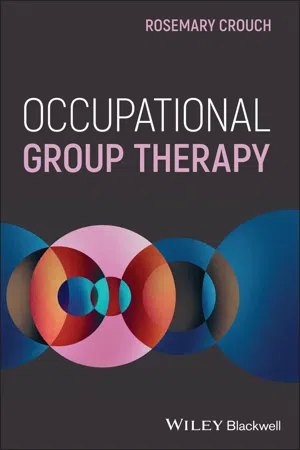
- English
- ePUB (mobile friendly)
- Available on iOS & Android
Occupational Group Therapy
About this book
OCCUPATIONAL GROUP THERAPY
Occupational Group Therapy helps group leaders achieve a higher and more dynamic level of therapeutic intervention, gain a better understanding of foundational concepts and research, and utilise active techniques that have meaningful and lasting effects on their clients. This practical guide encourages readers to use and develop their skills creatively in a range of interventions, including hospital-based work with acutely ill clients, physical acute care, and rehabilitation.
The text presents both the theoretical background and practical applications of occupational group therapy: core skills and concepts, styles of group leadership, clinical and ethical reasoning, and different models of therapy such as the functional group model, the model of human occupation (MOHO), and the occupational therapy interactive group model (OTIGM), alongside warm-up and ice-breaker techniques, role-play exercises, assertiveness and social skills training strategies, guidance on using psychodrama and the therapeutic spiral model (TSM) in group settings, andmore.
- Develops the skills and self-confidence occupational therapists need to be effective groupleaders
- Covers the functional and performance aspects necessary for occupational therapy intervention, including client handling, and structuring and communication skills.
- Discusses new ways of addressing common concerns and issues in various interventionsettings
- Offers ideas and techniques for using higher-level interventions, such as psychodrama andthe Therapeutic Spiral model
- Helps readers to design effective group experiences that allow their clients to "work on themselves" both inside and outside of the group
Written by an esteemed expert with decades of practical experience in the field, with a chapter from Louise Fouché, an accomplished occupational group therapist and developer of OTIGM, and foreword by Professor Emerita Sharon Brintnell, former President of World Federation of Occupational Therapy (WFOT): Occupational Group Therapy is a must-have teaching manual and guide for undergraduate and post-graduate occupational therapy students, and for practitioners looking to increase their use of group work as a therapeutic intervention.
Frequently asked questions
- Essential is ideal for learners and professionals who enjoy exploring a wide range of subjects. Access the Essential Library with 800,000+ trusted titles and best-sellers across business, personal growth, and the humanities. Includes unlimited reading time and Standard Read Aloud voice.
- Complete: Perfect for advanced learners and researchers needing full, unrestricted access. Unlock 1.4M+ books across hundreds of subjects, including academic and specialized titles. The Complete Plan also includes advanced features like Premium Read Aloud and Research Assistant.
Please note we cannot support devices running on iOS 13 and Android 7 or earlier. Learn more about using the app.
Information
SECTION 1
THE THEORETICAL BACKGROUND
CHAPTER 1
Frames of Reference Relevant to Occupational Group Therapy and the Classification of Groups
1.1 FRAMES OF REFERENCE
- To develop a milieu where clients feel accepted and that they belong.
- Facilitation of sharing of ideas, emotions and problems.
- Influence on the changing of attitudes.
- Development of identity, confidence and self‐esteem.
- Stimulation of motivation to carry out a task.
- Conflict resolution.
- Effective resource utilisation.
- Cost‐effectiveness.
- Instillation of hope.
- Universality.
- Imparting of information.
- Altruism.
- The recapitulation of the primary family.
- Developing socialisation techniques.
- Existential factors.
- Imitative behaviour.
- Group cohesiveness.
- Interpersonal learning.
- Catharsis.
- Reflective appreciation.
1.2 CLASSIFICATION OF GROUPS AND TYPES OF OCCUPATIONAL GROUP THERAPY: DEFINING THE SCOPE OF OCCUPATIONAL GROUP THERAPY ACCORDING TO THE LEVEL OF EMOTIONAL INTENSITY
- Skills‐focused groups.
- Occupational behaviour groups.
- Cognitive behavioural groups.
- Psychodynamic creative therapy groups (Finlay in Creek 2002).

- Groups to facilitate psychosocial adjustment to disability/illness.
- Education groups.
- Team‐building groups.
- Exercise groups.
- Skills training groups.
- Group empowerment.
- Activity groups: These are groups where members are involved in a common activity and are directed towards learning and maintaining occupational performance. This is explained in detail in Chapter 14.
- Intrapsychic groups: These are groups which deal with the insight into processes and conflicts that can occur within an individual. Psychodrama is a typical intrapsychic group and is explained in detail in Chapter 11.
- Social Systems groups: These are groups which follow the Systems Theory developed by Lewin (1951). They are aimed at increasing the interaction of participants.
- Growth groups: Growth Groups are generally aimed at increasing members' sensitivity to feelings or enhancing members ‘ability to help them through the power of the group’. Howe and Schwartzberg (1986, p. 31).They are aimed at personal growth through action‐orientated experiences. Growth groups are based on the principles of humanistic and existential philosophy and psychology that seek to fulfil the potential inherent in each person. These principles are explained in the writing of Rogers (1961), Shutz (1967), Perls et al. (1971) and Maslow (1962). Groups such as psychodrama, role‐play and assertiveness training fall into this category.
- has the skills and awareness to interact and share with others in a group
- has problems related to social interaction and relationships
- feels isolated and is without others to offer support or constructive advice
- is threatened by the intensity or intimacy of one‐to‐one work’.
- Family Therapy groups.
- Social work groups.
- Psychotherapy groups.
- Art, music, drama and movement therapy groups.
- Marriage counselling groups.
- Teaching groups.
CHAPTER 2
Research in Occupational Group Therapy
Table of contents
- Cover
- Table of Contents
- Title Page
- Copyright Page
- Dedication Page
- Author’s Biographies
- Preface
- Foreword
- Introduction
- SECTION 1: THE THEORETICAL BACKGROUND
- SECTION 2: THE PRACTICAL APPROACH TO OCCUPATIONAL GROUP THERAPY
- Appendix A: Community Stress Management Manual
- Appendix B: Assertiveness
- References
- Index
- End User License Agreement